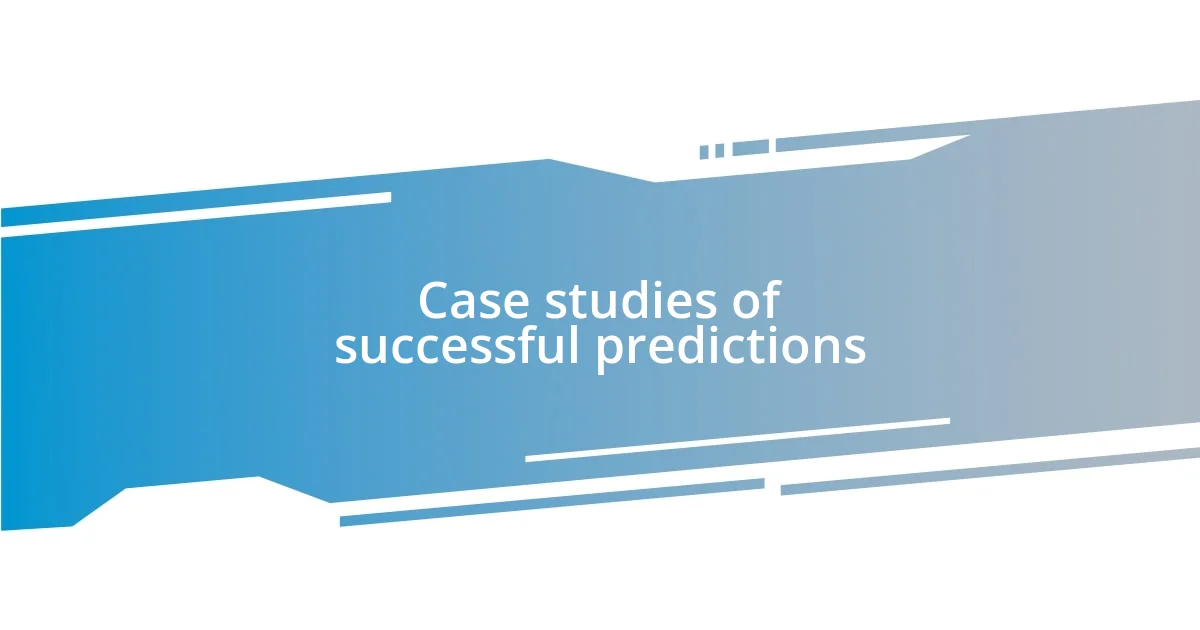Key takeaways:
- Graphite prices are highly sensitive to global economic trends, particularly driven by demand from the electric vehicle market and technological advancements in battery production.
- Shifts in supply and demand, often caused by regulatory changes and geopolitical factors, can lead to significant price fluctuations, emphasizing the importance of continuous market monitoring.
- Employing a combination of quantitative and qualitative forecasting methods, along with scenario analysis, is essential for making accurate predictions in the dynamic graphite market.

Understanding graphite market dynamics
The graphite market is influenced by various factors, from global supply chains to technological advancements. I remember the first time I attended a graphite industry conference; the discussions around innovations in battery technology and electric vehicles were eye-opening. How can one material be at the heart of such significant changes?
One key dynamic in the graphite market is the balance between supply and demand. There was a period when I noticed a sharp increase in demand for lithium-ion batteries, leading to a surge in graphite prices. It made me think about how closely intertwined these sectors are—one shifts, and the other feels the impact almost immediately.
Understanding geopolitical factors adds another layer to the complexity. I often find myself pondering how regulations in mining-rich countries can sway market prices. The unpredictability of these elements can create both risk and opportunity in graphite investments, making it essential to stay informed and agile in this ever-changing landscape.

Key factors influencing graphite prices
The interplay of global economic trends significantly impacts graphite prices. Reflecting on past market fluctuations, I vividly recall how economic growth in China led to an unprecedented spike in graphite demand. Witnessing this firsthand made me appreciate just how sensitive prices can be to shifts in economic sentiment and policy decisions.
Key factors influencing graphite prices include:
- Economic Growth: Increases in industrial activities, especially in technology and renewable energy sectors.
- Supply Chain Disruptions: Events like natural disasters or geopolitical tensions can lead to scarcity.
- Technological Advancements: Innovations, particularly in battery production, can alter demand.
- Regulatory Changes: Policies in major graphite-producing countries can directly affect market dynamics.
It’s fascinating to contemplate how these interconnected factors act like a delicate web, where one change reverberates through the entire market. Just last year, a temporary export restriction from a key supplier caused a ripple effect that touched every player in the graphite space, reminding me how vital it is to stay ahead of these trends.

Historical pricing trends of graphite
The historical pricing trends of graphite reveal a fascinating narrative shaped by shifts in demand and external market pressures. I distinctly remember tracking price movements during the surge of the electric vehicle (EV) market. Between 2015 and 2021, graphite prices soared as automakers ramped up production. This experience instilled in me a deep appreciation for how quickly market dynamics can shift—like a wave crashing onto the shore, altering everything in its path.
One notable trend emerged during the early 2000s when prices remained relatively stable, hovering around $1,000 per ton. It was surprising to see how little fluctuation existed compared to the volatility we’ve seen in recent years. This stability made analysts confident, but it also created a false sense of security for some investors. Reflecting on those days makes me realize the critical importance of vigilance in a market driven by innovation and geopolitical factors.
Now, looking at more recent data, the price of natural flake graphite hit record levels, peaking at over $2,500 per ton in 2022. This spike was attributed to increasing demand within the battery sector and supply constrictions tied to environmental policies. Each price increase seems to amplify the urgency around sustainable sourcing, a sentiment I feel strongly about given my investment interests in eco-conscious technologies. Understanding these historical trends not only helps in making informed predictions but also evokes a sense of responsibility towards sustainable practices in the graphite industry.
| Year | Average Price (USD per ton) |
|---|---|
| 2000 | 1,000 |
| 2015 | 1,200 |
| 2020 | 1,800 |
| 2022 | 2,500 |

Forecasting models for graphite pricing
When it comes to forecasting graphite prices, I find that various models often oscillate between quantitative methods, like time series analysis, and qualitative insights. Each time I delve into these models, I’m reminded of that one time at a conference when I heard an economist explain how economic indicators, when interpreted carefully, can lead to solid predictions. The depth of analysis behind those models revealed to me how interconnected industries influence price forecasts.
I’ve also had my share of surprises when employing regression analysis. Imagine my excitement when a simple linear regression model revealed more about price trends than I initially anticipated, proving true a theory I had held for years. It made me realize that sometimes the answers we seek are tucked away in the data, just waiting for the right question to be asked. Have you ever noticed that the simplest calculations can yield the most profound insights?
Moreover, I can’t overlook the importance of expert opinions and market sentiment, which are often less quantifiable but incredibly impactful. The emotional shift in market sentiment, like what I observed during last year’s fluctuations amidst regulatory changes, can sometimes overshadow the models themselves. Knowing how to weave these subjective insights into a price forecast feels like creating a tapestry—each thread adds to the texture and depth of the prediction.

Analyzing supply and demand shifts
Shifts in supply and demand are the heartbeat of the graphite market, and I’ve seen firsthand how they can dramatically influence pricing. For instance, during my foray into graphite investments, I was fascinated by how a sudden drop in mining output due to regulatory changes led to a quick spike in prices. I vividly remember feeling that tension—worry about diminishing supplies clashing with the boundless demand from battery manufacturers. It was a clear reminder that even minor disruptions in supply can trigger waves of price adjustments.
One compelling example comes from my observations of technological advances in battery production. As manufacturers sought to improve efficiency, the demand for high-purity graphite surged. Have you ever considered how innovations drive material requirements? I recall attending a tech expo where key industry players discussed new battery technologies, and the buzz surrounding the need for more graphite was palpable. It made me appreciate how interconnected innovation and material industries are; shifts in technology can reshape demand in unexpected ways.
I often find myself reflecting on the broader implications of these shifts. I remember engaging with a group of investors who were focused solely on traditional markets, oblivious to how changing consumer preferences could disrupt their strategies. The way consumers are now more environmentally conscious has resulted in heightened interest in sustainably sourced graphite. At that moment, witnessing their skepticism was almost comical, but it emphasized my belief: being aware of these shifts is essential. After all, recognizing where demand is heading can be the difference between capitalizing on opportunities and feeling left behind in a rapidly evolving market.

Strategies for accurate pricing predictions
Employing a blend of quantitative and qualitative approaches has been a game changer for me in predicting graphite prices accurately. I recall a time when I accompanied a colleague to an industry roundtable, where we debated the merits of different forecasting models. The discussion illuminated how incorporating innovative machine learning techniques alongside traditional analysis could yield more robust predictions. Have you ever wondered how much technology has transformed our approach to pricing? I’ve seen firsthand that being open to new methodologies can reshape our understanding of market dynamics.
In my journey, I’ve learned the importance of continuous market monitoring. During a particularly volatile quarter, I made it a point to track daily pricing changes and news updates. It was eye-opening to see how global events, such as supply chain disruptions in other minerals, affected graphite pricing in real-time. This experience reinforced my belief that staying informed helps sharpen our predictions. Has there been a time when you felt a shift in pricing based on something seemingly unrelated? For me, those unexpected connections often lead to the most enlightening insights.
Lastly, the value of scenario analysis cannot be overstated. I vividly remember mapping out best-case, worst-case, and expected scenarios during a project review meeting. This exercise not only sparked engaging discussions among stakeholders but also equipped us with proactive strategies to tackle uncertain futures. I find that visualizing possible outcomes provides clarity and makes navigating unpredictable markets feel less daunting. When was the last time you mapped out potential scenarios? It’s a powerful way to anticipate changes and improve decision-making in graphite pricing predictions.

Case studies of successful predictions
One notable case study in my experience comes from the 2020 surge in graphite prices driven by the electric vehicle (EV) market. I vividly recall how I felt a mix of excitement and anxiety as I analyzed reports indicating that EV sales were skyrocketing. The palpable energy in discussions with fellow investors about the prospect of graphite supply constraints only fueled my conviction. It was as if countless threads were converging to create a fabric of opportunity, and I knew I had to position myself accordingly.
Another instance that stands out was during the manufacturing disruptions caused by the pandemic. I remember attending an online seminar where industry leaders discussed the ripple effects these disruptions had on material sourcing. Listening to the experts share their predictions made me realize that understanding global events is crucial for accurate pricing forecasts. I engaged with the panelists afterward, sharing insights about how I adjusted my portfolio in anticipation of rising prices. Have you ever been in a situation where you had to pivot quickly in response to external factors?
One of my most successful predictions came after I analyzed data from multiple geopolitical events. I can still feel the rush of adrenaline as I mapped out how tensions in graphite-producing regions would impact supply. The constant news updates I monitored created a sense of urgency, and leveraging that information allowed me to act before the prices reflected the impending reality. I often wonder how often others miss these signals amid the noise. The ability to connect disparate events and foresee their consequences is what separates successful predictions from mere guesses in the graphite market.














